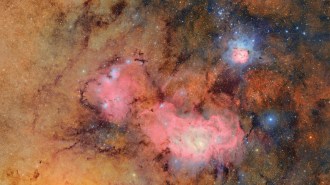The fuzzy body with the long, bright tail spotted by astronomers in January was a dead ringer for a comet. But the object’s location put that notion on the rocks: the body lies in the innermost part of the asteroid belt between Mars and Jupiter, on an orbit that no comet could have.

Instead, researchers have identified the body dubbed P/2010 A2 as a 120-meter-wide asteroid, the remnant of a slightly larger space rock that was recently hit by a much tinier denizen of the asteroid belt. The unseen collision vaporized the smaller body and stripped material from P/2010 A2, creating the debris initially mistaken for a comet’s tail.
Astronomers initially thought the suspected collision occurred just a few weeks before the asteroid was discovered. But a series of newly released images taken by the Hubble Space Telescope and the Rosetta spacecraft reveal that the dusty debris from the smashup is expanding sedately rather than flying off like shrapnel, indicating that the collision occurred about a year before P/2010 was discovered, two teams of astronomers report in the Oct. 14 Nature.
Although the smashup isn’t quite as recent as astronomers first thought, it’s new enough that the observations “open the door to the empirical study of the way asteroids die,” says David Jewitt of UCLA, the lead author of the Hubble study, which is available online at arXiv.org. “Now that we have seen the first example” of a freshly pummeled asteroid, he adds, “others are sure to follow.”
Collisions of rocky bodies are also thought to generate the disks of dust that surround stars believed to have planets. Because such disruptions are “such a close counterpart to what we observe in P/2010 A2,” Jewitt says, it’s likely that the Hubble and Rosetta studies will provide new insight into the generation of those disks.
The Hubble images show that P/2010 A2 is about 120 meters in diameter and is trailed by a dense X-shaped pattern of debris that peters out into a long diffuse tail. Particles in the trail range from millimeters to centimeters in size, Colin Snodgrass of the Max Planck Institute for Solar System Research in Katlenburg-Lindau, Germany, and the European Southern Observatory in Santiago, Chile, and his colleagues report in the same issue of Nature.
It’s likely that much smaller particles initially resided in the trail but were blown away by the pressure exerted by sunlight, Jewitt says. But David Nesvorný of the Southwest Research Institute in Boulder, Colo., who is not on either discovery team, says the lack of submillimeter-sized particles in the trail may speak volumes about the composition of the asteroid. The body may consist of a fragile agglomeration of debris no smaller than gravel, he suggests.







